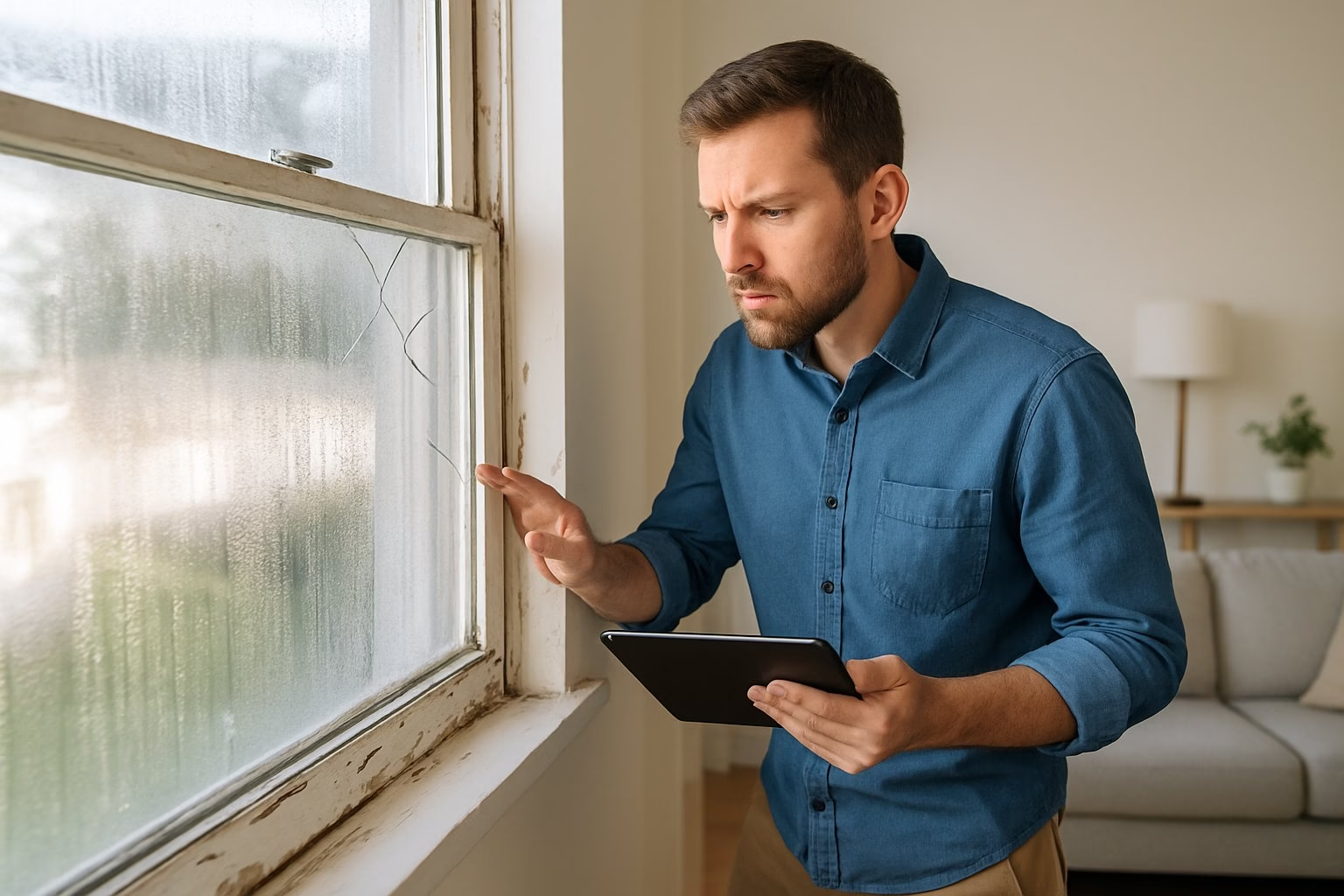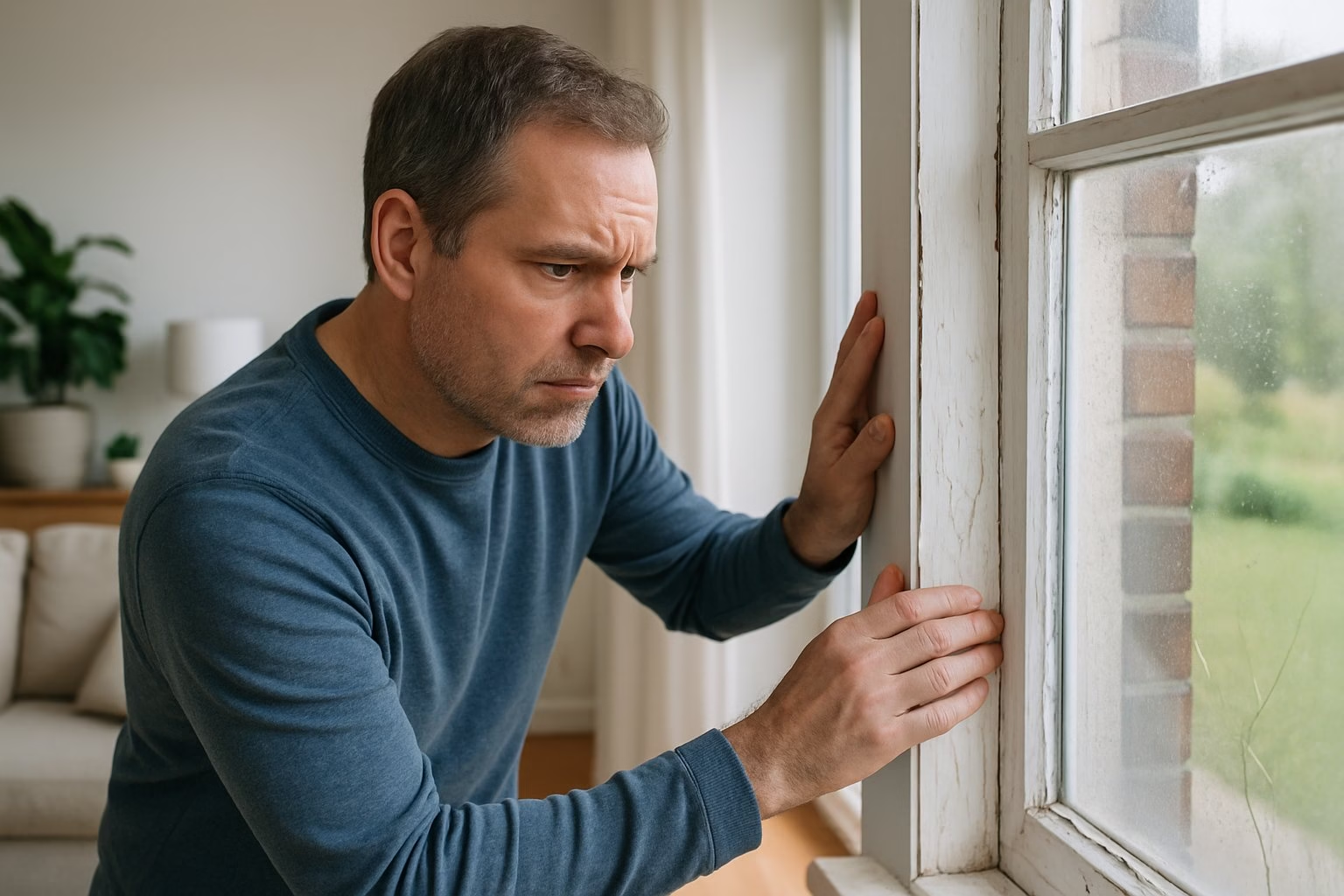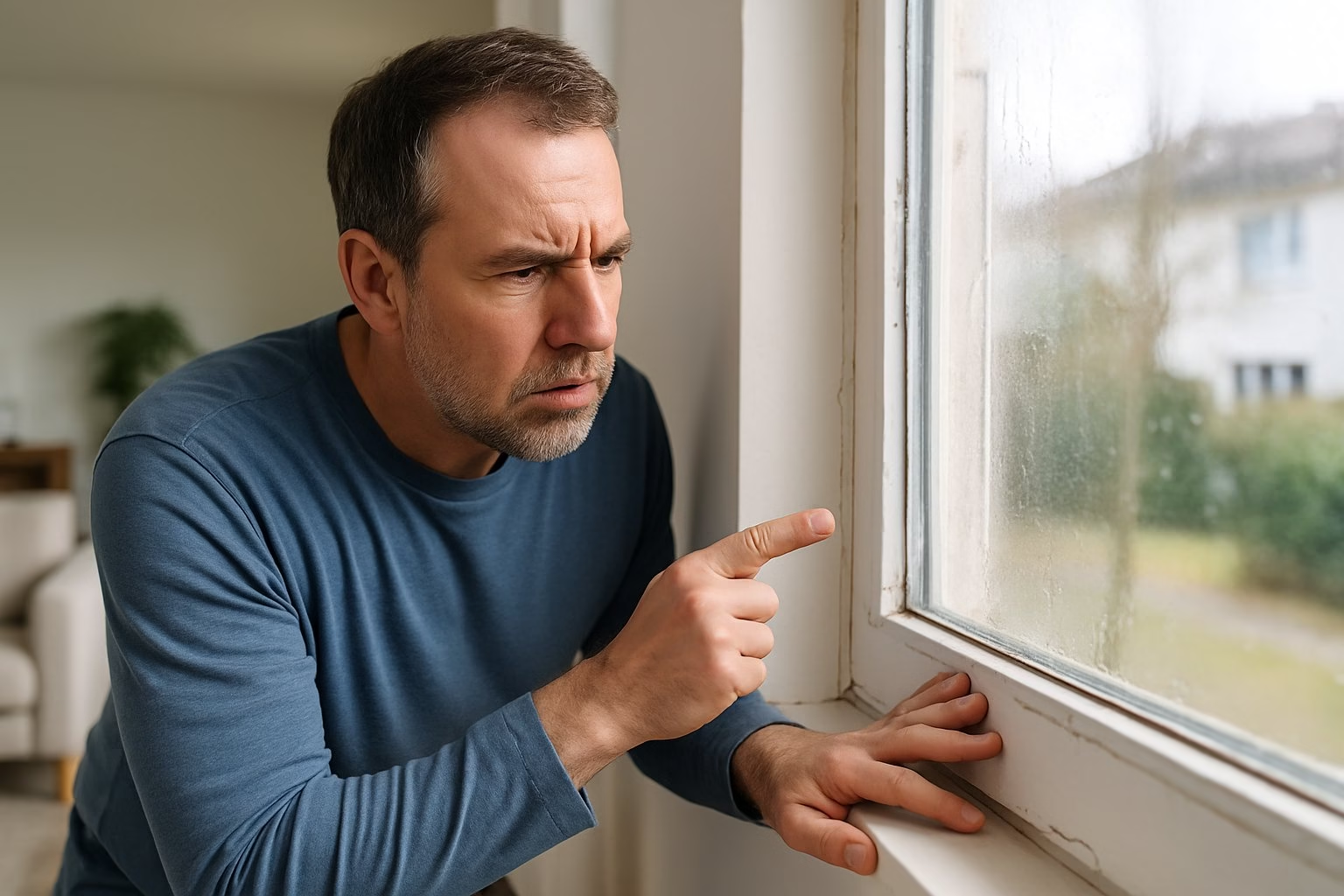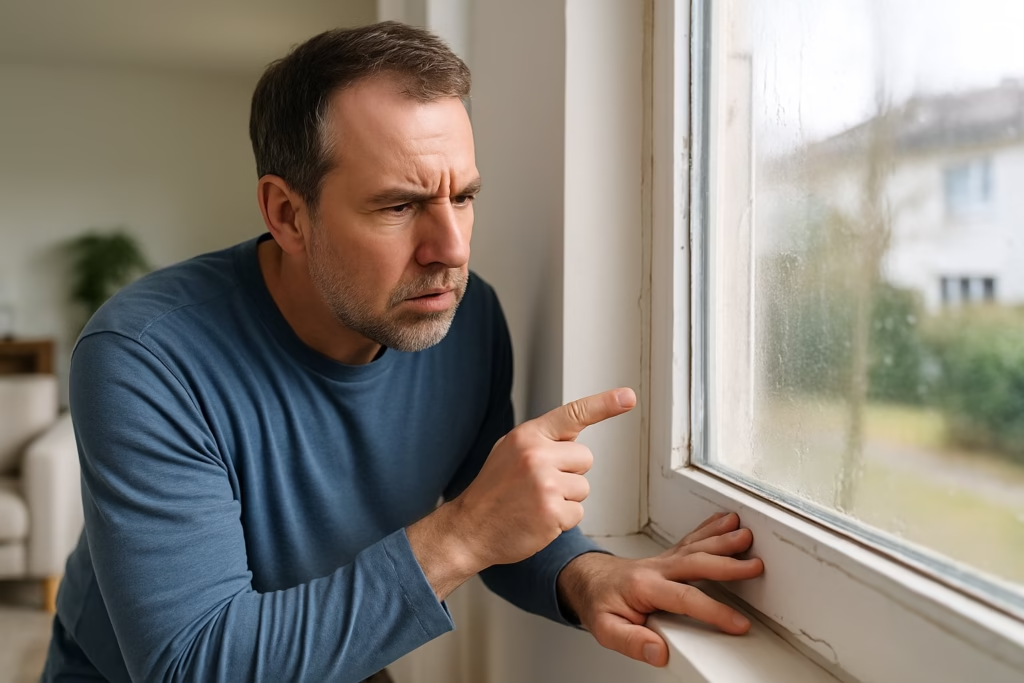Windows play a huge role in any home, yet most folks don’t notice when theirs are due for replacement. Old or damaged windows can really hike up your energy bills, make your house less comfortable, and let water damage sneak in.
Spotting the warning signs early can save you a ton on energy and spare you from pricey repairs later.

Most window issues start small and gradually get worse. Drafts, condensation between panes, and windows that just won’t open smoothly are all warning signs you shouldn’t brush off.
Since these problems creep up slowly, it’s easy to miss them until things get bad.
Key Takeaways
- Watch for drafts, condensation between glass panes, and windows that are tough to operate—these are clear signs you might need replacements.
- Higher energy bills and more outside noise usually mean your windows aren’t insulating like they should.
- Fixing window problems early keeps repair costs down and makes your home more comfortable and efficient.
Understanding the Importance of Timely Window Replacement

Replacing windows at the right time can keep you from wasting energy, which sometimes bumps up utility bills by as much as 25%. Wait too long, and you risk safety issues and repairs that cost way more than new windows ever would.
Impact on Home Comfort and Energy Efficiency
Windows have a direct impact on how your home feels year-round. Drafts make rooms chilly in winter and stuffy in summer, even when your HVAC is running full blast.
When windows leak energy, your heating and cooling systems end up working overtime. That can push bills up by 15% to 25% if you’re not careful.
Switching to energy-efficient windows cuts down on that waste. Most people see 15% to 20% savings on their heating and cooling after making the switch.
With solid windows, temperature control gets a lot easier. Rooms actually stay at the temperature you set, without weird hot or cold spots near the glass.
Good window seals also help with humidity, so you’re less likely to get condensation that can mess up your walls or furniture.
And if you’re tired of hearing every car that drives by, modern double or triple-glazed windows can block out up to half the noise.
Potential Risks of Delaying Replacement
If you put off window replacement, you’re opening the door to some real headaches. Water damage from leaky seals can rot out your window frames and the walls around them.
Moisture trapped between panes often leads to mold, which is no joke if someone in your house has allergies or breathing issues.
Windows that stick or won’t open can become a safety hazard. If you ever need an emergency exit, you don’t want to be fighting with a jammed window.
Old, weak windows also make your home an easier target for break-ins. Worn-out locks and flimsy frames don’t offer much protection.
And let’s be honest—energy costs just keep climbing if your windows are leaking air. What starts as a tiny draft can wind up costing you hundreds every year.
By the time water damage spreads to your walls or floors, repairs may cost more than just getting new windows in the first place.
Value Addition and Home Aesthetics
New windows can instantly make your home look better. Curb appeal jumps up with modern window styles and fresh frames.
They also boost your property value. Real estate pros say new windows recoup 70% to 80% of their cost when you sell.
Homes with updated windows catch buyers’ attention. Most people want a place that won’t need big repairs right after they move in.
Changing up window styles can even give your house a whole new vibe from the street. It’s like a mini makeover without a full renovation.
Inside, better glass and window designs let in more light. Rooms feel brighter, bigger—just more inviting overall.
Modern windows are also a breeze to maintain. They don’t need as much painting or sealing, which means less weekend work for you.
If you’re selling, new windows are a great selling point. Energy efficiency and recent upgrades always look good on a listing.
The 7 Warning Signs Homeowners Shouldn’t Ignore

When windows start to fail, they don’t exactly keep it a secret. Here are some major warning signs to watch for, so you can catch problems before they get expensive.
Difficulty Opening or Closing Windows
If your windows stick, jam, or take a ton of effort to move, something’s up. Usually, this happens because moisture has warped the frame or the foundation has shifted.
Common causes include:
- Wood frames swelling up from water
- Bent or damaged tracks
- Worn-out hardware
- Foundation settling out of alignment
Windows should open and close without a fight. If you’re wrestling with cranks or latches, the window’s probably past its prime.
Sticky windows aren’t just annoying—they’re a safety risk. You don’t want to get trapped in an emergency because a window won’t budge.
Visible Damage or Decay
If you see damage to the frame, sill, or glass, it’s time to act. Rotting wood, cracked frames, and broken seals mean the window can’t do its job anymore.
Key damage signs include:
- Soft or crumbly wood around the frame
- Paint peeling off and exposing bare wood
- Cracks in vinyl or aluminum
- Condensation trapped between glass panes
Water damage is the worst offender. Once moisture gets in, it can spread to your walls and lead to mold.
When double-pane windows lose their seal, moisture fogs up the glass and kills your insulation.
Noticeable Drafts or Air Leaks
Feel a breeze near your windows? That’s money flying out. Drafts and air leaks make your home less comfortable and more expensive to heat or cool.
Try these quick tests for leaks:
- Hold a candle by the window edges on a windy day
- Feel for moving air with your hand
- Check for light peeking through closed windows
- See if curtains or blinds move when it’s windy
Old weatherstripping can shrink, crack, or just fall off. Swapping it out might help for a bit, but it’s usually just a band-aid if your windows are getting old.
If you’ve got big air leaks, chances are the frames have shifted or warped. At that point, only full replacement really solves it.
Increased Energy Bills
Notice your heating or cooling bills creeping up? Your windows could be the culprit. Swapping old windows for energy-efficient ones can cut your bills by 10–25%.
Common ways energy escapes:
- Single-pane glass with barely any insulation
- Broken seals in double-pane windows
- Gaps around the frame
- No low-E coatings to reflect heat
Windows put in before 1990 usually miss out on modern energy-saving features. They let heat and cold right in or out.
Compare your energy bills to last year’s. If they’re going up for no obvious reason, your windows might be losing their edge.
Today’s replacement windows have double or triple panes, gas fills, and special coatings that really boost energy performance.
Less Obvious Indicators Your Windows Need Replacing
Some window problems are sneakier than broken glass or rotting wood. More outside noise, fog between the panes, or frames that look faded can all mean trouble—but they usually creep up slowly.
Excessive Noise From Outside
Old windows that don’t seal well let in way more noise. As seals break down, tiny gaps let sound travel straight through.
Suddenly, you’re hearing traffic, dogs, and lawn mowers like they’re right in your living room.
Noise clues your windows might be shot:
- You can hear people talking outside, clear as day
- Street noise keeps you up or interrupts your day
- It’s almost as loud with windows closed as open
Single-pane windows barely block any sound compared to newer double or triple-pane ones. The space between panes actually helps dampen noise.
Windows from before 1980 usually don’t have much soundproofing. Modern windows can cut down outside noise by 20–30 decibels if installed right.
Condensation Between Glass Panes
If you spot water or fog between the glass panes, the seals have failed. There’s really no fix for that except replacing the window.
The space between panes is supposed to be filled with dry air or argon gas. When the seal breaks, moisture sneaks in.
Look for these signs:
- Fog or cloudiness that doesn’t wipe away
- Water droplets trapped between the glass
- White or chalky residue inside the window
Once the seal goes, you lose all the insulation that window used to provide. The gas leaks out, and you’re left with regular air in there.
This kind of condensation gets worse when the temperature swings. Cold mornings and warm afternoons make the fog stand out even more.
Fading or Discoloration of Window Frames
If your window frames are changing color or fading, they’re probably breaking down from sun and weather. That’s bad news for both looks and strength.
Common problems by frame type:
- Vinyl: Yellowing, graying, or a chalky feel
- Wood: Faded paint, gray patches, or soft spots
- Aluminum: White oxidation, pitting, or corrosion
Discoloration usually means the protective coating is gone. Without it, frames just keep getting worse faster.
When frames fade, it’s a good bet the seals, hardware, and glass are wearing out, too. Everything tends to age at about the same pace.
How Aging Windows Affect Your Home’s Performance
Old windows can cause a bunch of problems that mess with your comfort and your wallet. When window parts wear out, your energy efficiency drops, your HVAC works harder, and your home gets easier to break into.
Reduced Insulation Capabilities
Window seals eventually break down. Outside air starts sneaking into the house, and suddenly, you’ve got drafty rooms and weird temperature swings.
Single-pane windows barely slow down heat or cold—they just let it right through. Double-pane windows with busted seals? They’re not much better, honestly.
Common insulation problems include:
- Cracked window frames letting in air
- Failed weatherstripping around the edges
- Broken seals between glass panes in multi-pane windows
- Gaps where the window meets the wall
Ever notice cold spots by your windows in winter? Warm air leaks out, cold air pushes in, and you end up cranking the heat just to feel comfortable.
Then summer hits, and it’s the opposite. Hot air seeps inside, cool air escapes, and the AC just can’t keep up.
Pressure on HVAC Systems
Drafty windows make your heating and cooling systems work way harder than they should. The furnace or AC runs longer, trying to keep up, and your energy bill climbs.
HVAC systems built for well-sealed homes struggle when windows leak air. They just can’t keep temperatures steady anymore.
Energy waste happens through:
- Heated air escaping in winter
- Cool air leaking out in summer
- Outdoor air constantly getting in
- HVAC equipment cycling on and off way too often
All that extra work wears out motors and compressors faster. Repairs pile up, and your equipment just doesn’t last as long.
Some folks see their energy bills jump by 25-30% with bad windows. In extreme weather, you might even see bills double. That adds up to a lot of wasted money every year.
Compromised Security
Old windows? They’re basically an open invitation. Frames warp, locks stop working, and latches get loose or break off entirely.
Security issues include:
- Windows that won’t lock all the way
- Frames pulling away from walls
- Glass that shatters easily
- Hardware that just doesn’t work anymore
Warped frames leave gaps even when the window looks closed. Anyone with a screwdriver could pop them open.
Single-pane glass breaks into big, sharp pieces, making break-ins quick and surprisingly quiet. Newer windows use safety glass that’s a lot tougher.
Failed locks give a false sense of security. Windows might look locked but open up with barely any effort from the outside.
Insurance companies sometimes require working locks on every window. If your hardware’s busted, you could have trouble with coverage after a break-in.
Assessing Replacement vs. Repair Options
Deciding between repairing and replacing your windows really depends on how bad the damage is, what the repairs will cost, and whether you’ll save enough on energy bills to make it worth it. Small issues? Usually fixable. But if you’ve got bigger problems, replacement starts to make more sense.
When Repairs Are Sufficient
Got a small crack in the glass? A pro can usually seal that up. If you’ve got a single broken pane in a double-hung window, just replacing the glass might do the trick.
Repairable Issues Include:
- Broken sash cords or chains
- Worn weatherstripping around frames
- Minor gaps causing small drafts
- Sticky or tough-to-use hardware
- Peeling paint on the frames
Hardware like locks, handles, or cranks—those are usually easy to swap out. Weatherstripping is pretty cheap, too, and can fix those little air leaks for $3-$8 per foot.
If rot only affects a small part of a wood frame (say, under 10%), a contractor can patch it and refinish the surface. No need to rip out the whole window.
Cost Considerations and Long-Term Benefits
Repairs usually run $150-$400 per window. Replacements? You’re looking at $300-$800 for a standard window. Energy-efficient replacements can cut heating and cooling costs by 10-25% each year, which is actually kind of impressive.
Repair vs. Replacement Cost Breakdown:
| Issue Type | Repair Cost | Replacement Cost |
|---|---|---|
| Glass replacement | $100-$300 | $300-$600 |
| Hardware fixes | $50-$150 | $300-$800 |
| Frame repairs | $200-$500 | $400-$1,000 |
Replacement windows usually insulate better and can bump up your home’s resale value by 70-80% of what you spend. Modern double or triple-pane windows just outperform repaired single-pane ones, no question.
Tax credits and rebates for energy-efficient windows can knock $150-$500 off the price per window, depending on where you live.
Choosing the Best Course of Action
Windows over 20 years old with lots of problems? Replacement almost always wins out. If repairs add up to more than half the cost of new windows, it’s time to let go.
If you’re facing multiple repairs at once, or the frames are really shot, replacing the whole setup makes more sense in the long run.
Choose Replacement When:
- Condensation shows up between double-pane glass
- Frames have major rot or warping
- Your energy bills have climbed a lot
- You’re dealing with several failing windows at once
Paying $100-$200 for a pro assessment can be worth it. Contractors spot hidden issues and help you decide what’s actually best.
If you live somewhere with harsh weather, replacement windows with better insulation can make a real difference in comfort and costs.
Getting Started With Window Replacement
Picking the right materials, hiring good people, and prepping your space—those are the big three for a smooth window replacement. These choices affect how comfortable your home feels, what you’ll spend on energy, and even your home’s value down the line.
Selecting the Right Window Materials
Vinyl windows are usually the best bang for your buck. They’re cheaper than wood or fiberglass, barely need any upkeep, and don’t rot or warp.
Wood looks gorgeous—especially in older homes—but it needs regular painting and sealing. If you care more about style than maintenance, wood’s the way to go.
Fiberglass windows are tough and handle temperature swings without a fuss. They cost more up front, but you’ll probably make it back in energy savings and fewer replacements.
| Material | Cost | Maintenance | Energy Efficiency |
|---|---|---|---|
| Vinyl | Low | Very Low | Good |
| Wood | High | High | Excellent |
| Fiberglass | High | Low | Excellent |
For most people, double-pane windows are plenty. If you live somewhere really cold, triple-pane windows insulate better but cost quite a bit more.
Hiring Qualified Window Professionals
Licensed contractors carry insurance and actually follow building codes. Always ask for their license number and double-check it with your state.
Get at least three quotes, in writing, from different folks. The quote should spell out labor, materials, permits—everything. If a quote looks way off compared to the others, something’s fishy.
Check references from jobs finished in the last couple years. Good contractors hand over customer info without hesitation. If you’re curious, drive by some of their recent work and see how it looks.
Look for contractors who back up their work with warranties—ideally 5-10 years for labor and a lifetime for the actual windows.
Steer clear of door-to-door sales or anyone who wants full payment upfront. Most reputable folks ask for 10-20% down, then the rest when the job’s done.
Preparing Your Home for Installation
Move furniture and decor at least three feet away from each window. Installers need space, and you don’t want your stuff covered in dust or getting dinged up.
Take down blinds, curtains, and any hardware before installation day. Stash them somewhere safe so nothing gets lost or broken.
Cover furniture with plastic or old blankets. Window work gets messy—dust and debris end up everywhere.
Expect some noise and disruption. Each window usually takes 30-60 minutes to swap out, so plan for a little chaos. If possible, have family members out of the house while the work’s happening.
Trim back bushes and move outdoor furniture away from exterior windows. Installers need a clear shot from outside, too.
Double-check that outlets near windows actually work. Installers often need to plug in power tools during the job.
Frequently Asked Questions
People always have questions about window replacement—when to do it, what it costs, and what happens if you wait too long. Here are some of the most common ones, with answers that get right to the point.
What are the clear indicators that my house windows need to be replaced?
If your windows are tough to open or close, that’s a red flag. The frames might be warped or the hardware’s just shot.
See water damage or stains around the frames? That’s a sure sign the seal has failed. Sometimes you’ll spot warped floors or feel extra humidity near the window, too.
If the glass looks foggy between panes, the seal’s broken and moisture is getting in. That kills your insulation.
Drafts are a giveaway. If you feel cold air in winter or your AC can’t keep up, your windows probably aren’t sealing anymore.
How do I assess the energy efficiency of my current windows to determine if they need replacing?
Your energy bills tell the story. Compare this year’s bills to last year’s, especially during similar weather. If they’re going up, there’s probably a problem.
Got single-pane windows? They’re energy sieves—no modern insulation, just glass between you and the elements.
Feel around your windows. If the area is colder or hotter than the rest of the room, you’ve got efficiency issues.
Check for condensation. Some moisture on the glass is normal, but if it’s between the panes, your seal’s toast.
Can you describe the symptoms of window failure I should be watching for in my home?
Windows should open and close smoothly. If they stick, jam, or make grinding noises, something’s wrong.
Look for rotting wood, rusty metal, or cracked vinyl on the frames. Those materials don’t last forever.
If you feel air moving around the window edges, even when they’re closed, air’s getting in—never a good sign.
When outside noise suddenly seems louder, it often means your window seals have failed.
What are the potential risks or disadvantages of postponing window replacement?
Letting failing windows go means you’ll keep paying more for heating and cooling. Those costs add up fast.
Leaks lead to water damage, mold, and sometimes serious structural issues. Fixing those problems costs way more than replacing a window.
Windows that don’t lock properly are a security risk. Broken hardware makes it easier for someone to break in.
Poor seals let in dust, pollen, and other outdoor junk, which can mess with your indoor air quality and maybe even your health.
How does window condition impact overall home value and curb appeal?
Outdated windows knock down property value when it’s time to sell. Most buyers spot old windows and immediately think about the cost and hassle of replacing them.
Curb appeal really takes a hit if your windows look worn out or damaged. Cracked glass, peeling frames, or a weird mix of window styles can make the whole house seem neglected.
These days, buyers care about energy efficiency too. If your windows have decent insulation, that’s a big plus for folks who want to save on energy bills.
New windows usually bring back about 70-80% of what you spend if you sell. Besides that, they just make your home feel better to live in right away.
What are the most cost-effective window replacement options for homeowners on a budget?
Vinyl windows usually come with the lowest upfront costs and still manage to deliver decent energy efficiency. They tend to run about 20-40% cheaper than wood or fiberglass options, which is a pretty big difference if you’re watching your wallet.
The timing of your replacement project can really change how much you spend. If you swap out several windows at once, you’ll likely save more than if you tackle them one by one.
Standard-sized windows are generally more affordable than custom ones. Take the time to measure your existing window openings—if you can go with standard replacements, that’s money in your pocket.
Don’t forget about energy rebates and tax credits, either. Plenty of utility companies and government programs toss out incentives for energy-efficient window installs, so it’s worth checking what’s available in your area.

